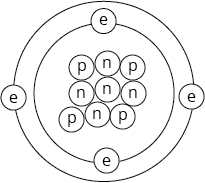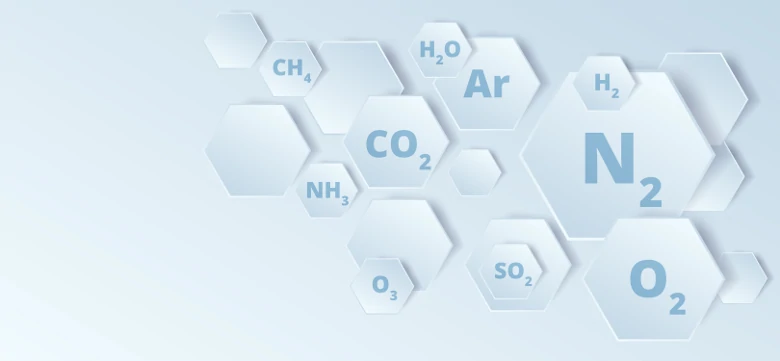Atomic Structure
In this article, we will be covering the topic on atomic structure. The learning outcomes are as follows:
- Describe the structure of an atom.
- State the relative charges and relative masses of the subatomic particles.
- Define proton (atomic) number and nucleon (mass) number.
- Deduce the numbers of protons, neutrons, and electrons in an atom.
- Interpret and use symbols such as \(\mathrm{\displaystyle{^{^{12}}_{_{\,6}}{C} }}\).
The content covered in this article is as per the requirements of the Secondary 3 Chemistry syllabus in Singapore.
Structure of an Atom
All matter is made up of atoms. An atom is the smallest particle of an element. So what is an atom made up of?
An atom is made up of subatomic particles. Subatomic particles are the smaller particles that make up the entire atom. They are:
- protons
- neutrons and
- electrons
Let us have a look at the structure of an atom.

The atom consists of a nucleus (in the centre), where the protons and neutrons are tightly packed together.
The electrons are found orbiting around the nucleus in regions known as the electron shells.
Characteristics of Subatomic Particles
Now, let us take a look at some of the characteristics of the subatomic particles. In particular, we will learn about their location, relative mass and the relative charge.
| Location | Relative Mass | Relative charge | |
|---|---|---|---|
| proton | inside the nucleus | \(1\) | \(+1\) |
| neutron | inside the nucleus | \(1\) | \(0\) |
| electron | outside the nucleus, in the electron shells | \(\displaystyle{\frac {1}{1840}}\) | \(-1\) |
What makes up the mass of an entire atom?
The mass of the entire atom comes mainly from the protons as well as the neutrons which are found in the nucleus of the atom.
This is because the relative mass of the electron is \(\displaystyle{\frac {1}{1840}}\), which is rather negligible as compared to the relative mass of the proton or the relative mass of the neutron which are both equal to 1. Hence, the mass of an atom is considered to be close to the total mass of the protons and neutrons.
What is the proton number?
The proton number is also called the atomic number.
The proton number of an atom refers to the number of protons in the atom.
The elements in the Periodic Table are arranged in order of increasing proton number. Each element in the Periodic Table has a unique proton number.
What is the nucleon number?
The nucleon number is also known as the mass number of an atom. The nucleon number of an atom is the total of the number of protons and neutrons in the atom.
Interpreting Symbols \(\mathrm{\displaystyle{^{^{A}}_{_Z}{X} }}\)
We can represent an element’s nucleon number and proton number using the symbol \(\mathrm{\displaystyle{^{^{A}}_{_Z}{X} }}\).
\(\Huge{\mathrm{\displaystyle{^{^{A}}_{_Z}{X} }}}\)
The number at the top (in superscript) - \(\text{A}\) represents the mass number or the nucleon number.
The number at the bottom (in subscript) - \(\text{Z}\) represents the atomic number or the proton number.
The symbol \(\text{X}\) represents the chemical symbol of the atom.
Chemists use chemical symbols to represent elements. Each symbol may consist of one or two letters. If the chemical symbol consists of only one letter, then the letter must be a capital letter. However, if the chemical symbol consists of two letters, then only the first letter will be a capital letter.
Take sodium as an example.
\(\Huge{\mathrm{\displaystyle{^{^{23}}_{_{11}}{Na}}}}\)
The element sodium is represented by the chemical symbol, \(\text{Na}\).
An atom of sodium has a proton number of \(11\) and a nucleon number of \(23\).
This tells us that an atom of sodium contains \(11\) protons.
\(\begin{align} \text{Nucleon number} &= \text{Number of protons} \\ & \qquad\qquad+ \\ & \quad\text{ Number of neutrons}\\[2ex] 23 &= 11 + \text{Number of neutrons} \end{align} \)
\(\begin{align} \text{Hence, Number of neutrons} &= 23 − 11\\[2ex] &= 12 \end{align} \)
How many electrons does an atom have?
An atom is electrically neutral. As the charges on protons and electrons are opposite but equal in magnitude, the number of protons and electrons must be the same in an atom, so the negative charges cancel out the positive charges and there is no net charge in an atom.
Thus, for the sodium atom, there will be 11 electrons.
Example 1:
Determine the number of protons, neutrons and electrons in the following atoms.
\(\Huge{\mathrm{\displaystyle{^{^{80}}_{_{35}}{Br}}}} \qquad \Huge{\mathrm{\displaystyle{^{^{31}}_{_{15}}{P}}}}\)
Solution:
Bromine
Proton number of Bromine \(\text{(Br)} = 35\)
Number of protons \(= 35 \)
Since an atom is electrically neutral, the number of protons is the same as the number of electrons.
Number of electrons \(= 35 \)
Nucleon number of Bromine \(\text{(Br)} = 80\)
\(\begin{align} \text{Nucleon number} &= \text{Number of protons} \\ & \qquad\qquad+ \\ & \quad\text{ Number of neutrons}\\[2ex] 80 &= 35 + \text{Number of neutrons} \end{align}\)
\(\begin{align}\text{Number of neutrons} &= 80 - 35\\[2ex] &= 45 \end{align}\)
Phosphorus
Proton number of Phosphorus \(\text{(P)} = 15\)
Number of protons \(= 15\)
Since an atom is electrically neutral, the number of protons is the same as the number of electrons.
Number of electrons \(= 15\)
Nucleon number of Phosphorus \(\text{(P)} = 31\)
\(\begin{align} \text{Nucleon number} &= \text{Number of protons} \\ & \qquad\qquad+ \\ & \quad\text{ Number of neutrons}\\[2ex] 31 &= 15 + \text{Number of neutrons} \end{align}\)
\(\begin{align}\text{Number of neutrons} &= 31 - 15\\[2ex] &= 16 \end{align}\)
Example 2:
Determine the number of protons, neutrons, and electrons in the following atom.
\(\Huge{\mathrm{\displaystyle{^{^{1}}_{_{1}}{H}}}}\)
Solution:
Proton number of Hydrogen \(\text{(H)} = 1\)
Number of proton \(= 1\)
Since an atom is electrically neutral, the number of protons is the same as the number of electrons.
Number of electron \(= 1\)
Nucleon number of Hydrogen \(\text{(H)} = 1\)
\(\begin{align} \text{Nucleon number} &= \text{Number of protons} \\ & \qquad\qquad+ \\ & \quad\text{ Number of neutrons}\\[2ex] 1 &= 1 + \text{Number of neutrons} \end{align}\)
\(\begin{align}\text{Number of neutrons} &= 1 - 1\\[2ex] &= 0 \end{align}\)
Example 3:
Complete the table below.
| Chemical Symbol | Atomic Number | Mass Number | Number Of | ||
|---|---|---|---|---|---|
| protons | neutrons | electrons | |||
| Fe | 26 | 30 | |||
| Y | 89 | 39 | |||
| 30 | 65 | ||||
| Sn | 50 | 69 | |||
| Re | 111 | 75 | |||
| 85 | 37 | ||||
| Te | 52 | 76 | |||
Solution:
| Chemical Symbol | Atomic Number | Mass Number | Number Of | ||
|---|---|---|---|---|---|
| protons | neutrons | electrons | |||
| Fe | 26 | 56 | 26 | 30 | 26 |
| Y | 39 | 89 | 39 | 50 | 39 |
| Zn | 30 | 65 | 30 | 35 | 30 |
| Sn | 50 | 119 | 50 | 69 | 50 |
| Re | 75 | 186 | 75 | 111 | 75 |
| Rb | 37 | 85 | 37 | 48 | 37 |
| Te | 52 | 128 | 52 | 76 | 52 |
Question 1:
Which of the following are found in the nucleus of an atom?
- electrons and neutrons
- electrons and protons
- protons only
- protons and neutrons
Solution:
(D) protons and neutrons
Explanation:
Only the protons and neutrons are found in the nucleus of an atom. The electrons are located outside the nucleus and moving rapidly in regions called the electron shells.
Question 2:
Which of the following correctly shows the relative mass and charge of a neutron compared to a proton?
\(\text{Relative mass} \qquad\qquad \text{Charge}\)
- \(\displaystyle{\frac {1}{1840}\qquad\qquad\qquad\qquad\quad 0}\)
- \(\displaystyle{\frac {1}{1840}\qquad\qquad\qquad\qquad -1}\)
- \(\displaystyle{1 \qquad\qquad\qquad\qquad\quad \frac {1}{1840}}\)
- \(\displaystyle{1 \qquad\qquad\qquad\qquad\qquad 0}\)
Solution:
(D) \(\displaystyle{1 \qquad\qquad\qquad\qquad\qquad 0}\)
Explanation:
A neutron has a relative mass of \(1\) and a relative charge of \(0\).
A proton has a relative mass of \(1\) and a relative charge of \(+1\).
An electron has a relative mass of \(\displaystyle{\frac {1}{1840}}\) and a relative charge of \(-1\).
Question 3:
Which of the following statements is true?
- The nucleon number is the number of neutrons in the nucleus.
- The nucleon number is the sum of the number of neutrons and protons.
- The proton number of the number of neutrons in the nucleus.
- The proton number is the sum of the number of protons and electrons.
Solution:
(B) The nucleon number is the sum of the number of neutrons and protons.
Explanation:
The proton (atomic) number refers to the number of protons in an atom.
The nucleon (mass) number is the total number of protons and neutrons in the atom.
Question 4:
The diagram below shows the structure of an atom of element X. What is X?

- Alumunium
- Beryllium
- Boron
- Fluorine
Solution:
(B) Beryllium
Explanation:
An atom of element X contains \(4\) protons, \(5\) neutrons, and \(4\) electrons. The element with a proton number of \(4\) is Beryllium.
Question 5:
Determine the number of neutrons in an atom of Radium, \(\mathrm{^{^{226}}_{_{88}}Ra}\).
- \(88\)
- \(138\)
- \(226\)
- \(314\)
Solution:
(B) \(138\)
Explanation:
Proton number of Radium \(\text{(Ra)} = 88\)
Number of protons \(= 88\)
Nucleon number of Radium \(\text{(Ra)} = 226\)
\(\begin{align} \text{Nucleon number} &= \text{Number of protons} \\ & \qquad\qquad+ \\ & \quad\text{ Number of neutrons}\\[2ex] 226 &= 88 + \text{Number of neutrons} \end{align}\)
\(\begin{align}\text{Number of neutrons} &= 226 - 88\\[2ex] &= 138 \end{align}\)
Question 6:
Read the following statement.
“ The nucleus of an oxygen atom contains 16 neutrons and 8 protons.”
Do you agree with the statement above? Give a reason for your answer.
Solution:
The statement is wrong. An atom of oxygen has a nucleon (mass) number of \(16\) and a proton number of \(8\). Hence, an atom of oxygen has \(8\) protons, the nucleus will contain \(8\) neutrons \((16 − 8 = 8)\).
Conclusion
Through this article, we have discussed the structure of an atom and the subatomic particles along with their characteristics. We have also learned how to interpret symbols and use the nucleon and proton number to deduce the number of protons, neutrons, and electrons in an atom.
Keep Learning! Keep Improving!


 SG
SG  VN
VN 


















